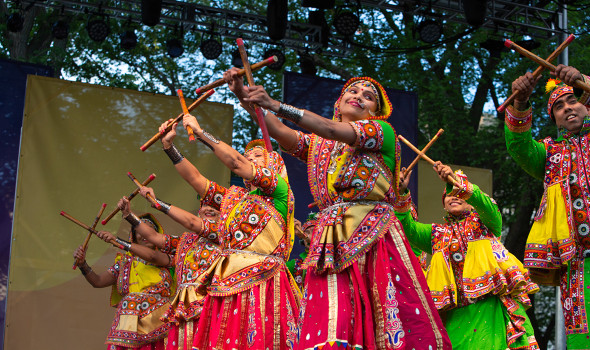Garba360 is returning to the festival stage in 2023, bringing the energetic and culturally rich Gujarati folk dances of Garba and Raas to a wider audience. This free outdoor event is perfect for families, offering dance lessons, captivating performances, and live music, all celebrating community and heritage through the joy of movement.
CLICK HERE to find out more about the Garba360 event and how you can participate in this unique cultural experience.
But what exactly is Garba? Originating from the state of Gujarat in India, Garba is more than just a dance; it’s a vibrant expression of community, spirituality, and cultural identity. Let’s delve into the fascinating world of Dance Garba, drawing insights from resources like the Lincoln Center to understand its significance.
What is Dance Garba? Exploring the Roots of a Folk Tradition
Garba is a traditional folk dance form that hails from Gujarat, India. It’s a communal circle dance, often performed in the heart of villages and cities alike, fostering a sense of unity and togetherness. The term “garba” itself encompasses both the dance form and the celebratory event where it takes place. Historically, garba served as a central social and religious activity in Gujarati villages, with entire communities participating in the rhythmic movements. This tradition continues to thrive, showcasing the enduring appeal of dance garba.
Dance Garba and the Navratri Festival: A Nine-Night Celebration
Garba dance is intrinsically linked to Navratri, a major Hindu festival celebrated over nine nights. Navratri, meaning “nine nights,” is dedicated to the worship of Durga, the divine feminine power and her nine different forms. Across India, Navratri is observed with diverse customs, but in Gujarat, it is uniquely celebrated with nine nights of energetic dance garba. As a form of devotion to Durga, men and women engage in dance garba from evening until late night. Many also observe fasting and dietary restrictions during these auspicious nine days. While Navratri is the most prominent time for dance garba, it is also joyfully performed at weddings, parties, and other social gatherings, highlighting its versatility and widespread appeal.
The Symbolism and Meaning Behind Dance Garba
Dance garba is deeply symbolic, revering the feminine divine and the cyclical nature of life. The word “garba” originates from the Sanskrit word “garbha,” meaning “womb.” Traditionally, the dance is performed around a centrally placed clay lantern with a light inside, known as a garbha deep, symbolizing the womb and the divine energy within. This garbha deep represents the body as a vessel for the divine Goddess or Devi. Dancing around this symbol honors the inherent divinity within every individual. Today, it is also common to place images of Durga at the center of the circle, further emphasizing the divine feminine aspect.
 People performing Garba dance at night
People performing Garba dance at night
The circular formation of dance garba, often evolving into concentric circles with larger groups, embodies the Hindu concept of time as cyclical. From birth to life, death, and rebirth, the cycle continues, with the Goddess remaining as the constant, unchanging element amidst the perpetual motion of the universe. This symbolizes that the divine, represented in the feminine form here, is the only constant in an ever-changing world.
Reflecting its spiritual roots, dance garba is traditionally performed barefoot, regardless of the surface. This practice signifies respect for the earth, considered the sacred mother. The feet, being the part of the body that touches the earth, are seen as conduits for the earth’s vital energy. Dancing barefoot is another way to connect with Devi and draw energy from the earth.
Dance garba is a captivating blend of tradition, community, and spiritual expression. As you explore this vibrant dance form, you’ll discover a rich tapestry of culture and meaning. For a firsthand experience of this incredible tradition, don’t miss the free Garba360 event! Click here for more details about Garba360 >
